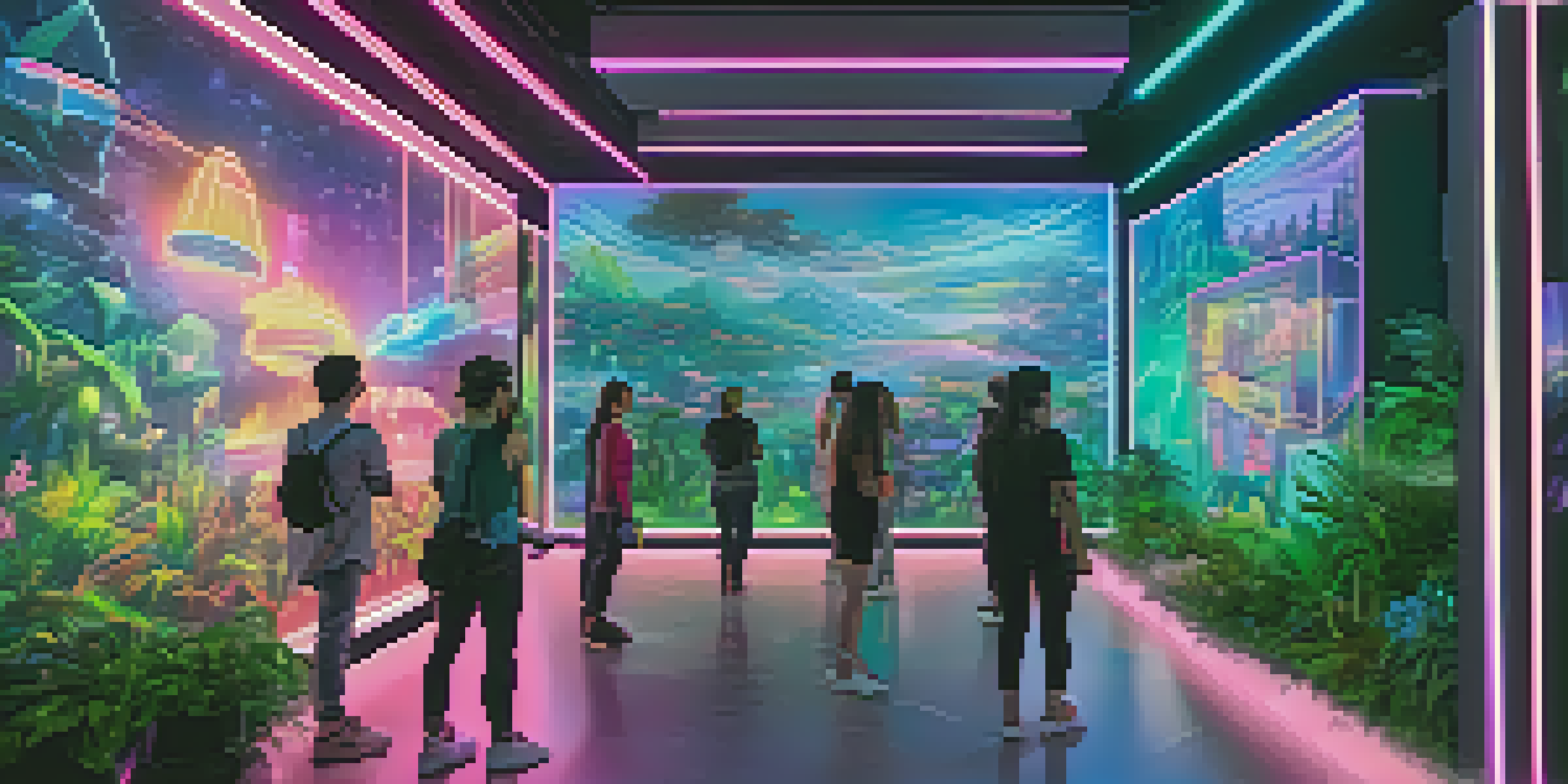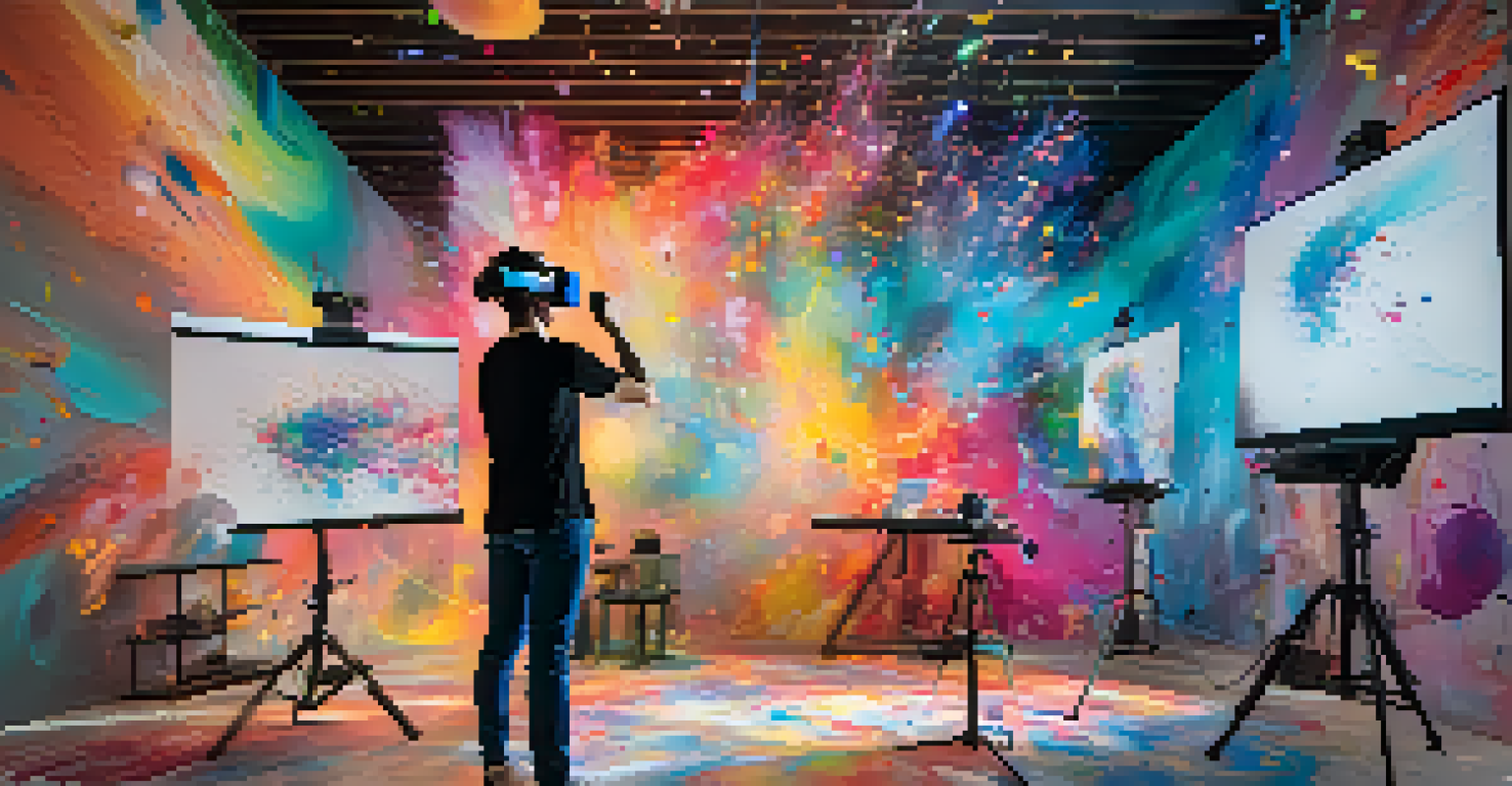The Impact of Virtual Reality on the Art Market Dynamics

Understanding Virtual Reality and Its Role in Art
Virtual reality (VR) is a technology that immerses users in a computer-generated environment, allowing them to interact with 3D spaces. In the art world, VR offers a new medium for creation and experience, inviting artists to push the boundaries of traditional art forms. This technology not only changes how art is made but also how it's perceived, making it a vital aspect of contemporary art discussions.
Virtual reality is not just about the technology; it's about the experience and the emotions it evokes.
For instance, artists can now create virtual galleries that viewers can explore from the comfort of their homes. This accessibility opens up art to a broader audience, breaking down geographical barriers that often limit exposure to art. As a result, both artists and collectors are beginning to see VR as an essential part of their practice and engagement with the art market.
Moreover, integrating VR into the art experience can enhance emotional connections, allowing viewers to feel as though they are part of the artwork. This immersive quality can transform how we appreciate art, shifting it from a passive observation to an active participation. With VR, the art market finds a new way to stimulate interest and cultivate a community.
Changing the Landscape of Art Exhibitions
Virtual reality is revolutionizing art exhibitions, offering innovative ways to showcase artwork. Traditional galleries often have physical limitations, but VR can transport visitors to fantastical worlds where art is displayed in unique formats. Imagine walking through a gallery that exists solely in a digital space, where each artwork can be interacted with in a way that defies conventional boundaries.

This shift not only attracts tech-savvy audiences but also appeals to those who may have never set foot in a physical gallery. By hosting virtual exhibitions, artists can reach potential buyers and fans around the globe, vastly expanding their audience. This democratization of art access allows for more diverse voices and artworks to be celebrated.
VR Transforms Art Accessibility
Virtual reality breaks geographical barriers, allowing broader audiences to engage with art through immersive virtual galleries.
Furthermore, VR exhibitions can incorporate multimedia elements, such as sound, light, and animation, creating a multi-sensory experience that enhances the viewer’s understanding of the artwork. This immersive engagement can lead to deeper appreciation and discussion about art, fostering a richer dialogue within the art community.
The Rise of Virtual Art Collecting
With the advent of virtual reality, the concept of art collecting is evolving. Virtual art galleries allow collectors to curate their own spaces, showcasing their collections digitally. This not only provides a platform for artists and collectors to connect but also creates a new market for buying and selling art in virtual environments.
The future of art is in technology, and virtual reality is paving the way for new forms of expression.
Moreover, as digital art gains recognition and value, collectors are increasingly investing in NFTs (non-fungible tokens), which represent ownership of digital artwork. This trend blurs the lines between physical and digital assets, prompting questions about the future of ownership in the art market. The rise of virtual art collecting challenges traditional notions of what constitutes valuable art.
As collectors explore these new avenues, they can discover emerging artists and innovative works that may have been overlooked in traditional markets. This shift encourages a more inclusive art ecosystem, where diverse artists can thrive and gain visibility, ultimately enriching the art world.
Impact on Pricing and Valuation of Art
The integration of virtual reality in the art market is also influencing pricing and valuation practices. Traditionally, art valuation has relied heavily on physical presence and provenance, but VR allows for new methods of assessment. As virtual and digital artworks become more prevalent, collectors and appraisers must adapt their approaches to reflect the changing landscape.
For instance, the market for digital art and NFTs has seen significant fluctuations, leading to evolving price points based on demand and rarity. This shift necessitates a deeper understanding of digital assets and their intrinsic value, which can differ greatly from physical artworks. As a result, appraisers and collectors are now navigating uncharted waters in determining worth.
New Trends in Art Collecting
The rise of virtual art galleries and NFTs is reshaping how collectors curate and invest in digital artwork.
Additionally, the accessibility of virtual exhibitions can lead to broader market trends, where the popularity of certain styles or artists can quickly shift. This dynamic nature of virtual art can create opportunities for strategic investments, allowing collectors to capitalize on emerging trends before they become mainstream.
Building Communities Through Virtual Engagement
One of the most exciting impacts of virtual reality on the art market is its ability to foster community engagement. Artists can now create virtual spaces where fans can interact with them directly, leading to more meaningful connections. This level of engagement helps build a loyal following and encourages collaborative projects that may not have been possible in the physical realm.
Furthermore, virtual reality can facilitate art discussions and workshops, allowing artists and collectors to share ideas and techniques in a more interactive setting. This communal aspect promotes learning and growth within the art community, creating a supportive environment for emerging artists. By bringing people together, VR enhances the social aspect of art appreciation.
As more artists embrace virtual platforms, we can expect to see a surge in collaborative projects and cross-disciplinary initiatives. These partnerships can lead to innovative works that blend various art forms, further enriching the cultural landscape. Ultimately, virtual reality is not just changing the way we consume art; it's reshaping the very fabric of art communities.
Challenges and Limitations of Virtual Reality in Art
Despite its many advantages, the integration of virtual reality into the art market comes with challenges. One major hurdle is the technological barrier; not everyone has access to VR equipment, which can limit participation. Additionally, the learning curve associated with navigating virtual spaces may deter some potential users, particularly those who are less tech-savvy.
Moreover, there are concerns about the authenticity and originality of digital artworks. As digital art becomes more prevalent, questions arise regarding copyright and ownership, especially in the context of NFTs. Artists and collectors must navigate these complexities to ensure that their works are protected and valued appropriately.
Community Engagement Through VR
VR fosters meaningful connections between artists and fans, encouraging collaborative projects and enriching art communities.
Lastly, while VR can create immersive experiences, it may lack the tactile engagement that comes with physical art. The emotional connection people often feel when viewing art in person is difficult to replicate in a virtual environment. As the art world continues to embrace VR, finding a balance between digital and physical experiences will be crucial for fostering genuine connections.
The Future of Art in a Virtual Reality Landscape
As we look ahead, the future of the art market in a virtual reality landscape appears promising. The technology is evolving rapidly, and as it becomes more accessible, we can expect to see an even greater integration of VR in the art world. Artists are likely to experiment with new forms and ideas, expanding the definition of what art can be.
Moreover, as more galleries and institutions adopt VR, we may witness a shift in how art is curated and presented. Curators will have the opportunity to create entirely new experiences that challenge traditional norms. This evolution could lead to a more inclusive art environment, where diverse perspectives and styles are celebrated.

Ultimately, the impact of virtual reality on the art market dynamics is just beginning. As artists, collectors, and audiences embrace this technology, we will continue to see innovative developments that redefine our relationship with art. The intersection of creativity and technology promises to usher in a new era of artistic expression and appreciation.